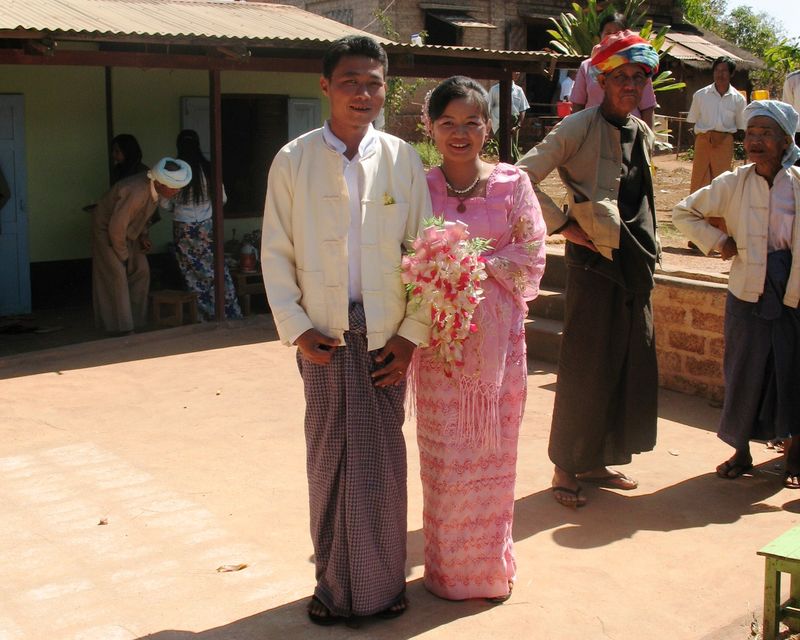Myanmar Wedding Traditions
Myanmar weddings, known as "mingala saung," involve traditional rituals where the couple informs their neighbors of their intent to marry and undergoes a series of ceremonies including blessings from monks and offerings to home spirits. The wedding ceremony features the couple in traditional attire, a procession led by a master of ceremony, and symbolic acts like the binding of palms and the exchange of garlands and rings. Post-wedding celebrations include a reception with music and a playful tradition where friends and family negotiate for "gei-bo" or pocket money before the couple can retire to their bedroom.
Myanmar Wedding
Myanmar is a country in the southeast of Asia. According to the government data 135 ethnic groups live in the country. The Bamar people make about 68% of total population. Buddhism is the dominate religion with 87.9% of Myanmar population. In Myanmar the wedding is known as "mingala saung" which could be translated as something that brings luck.
In Myanmar a couple traditionally has to inform seven homes in their neighbourhood on their decision to get married. This is regarded enough to be treated as married.
Still in contemporary society a marriage is a group of ceremonies like in other countries. Parents of both bride and groom, family elders, buddhist monks and people fom the state office are all participating in the wedding.
Just to be on the safe side two families often consult a local astrologer. Some partners are not suitable. For example, a person born on Saturday and the one born on Thursday.
According to a traditional Myanmar calendar there are several months suitable for a successful future relationship. One of those months is Nayone (June). There are no weddings during Buddhist lent which is period from July to October.
Everything starts with a visit of the groom's parents or a family elder to the bride's family. They have to agree on details like time and place of the wedding, guests etc. Usually there is no dowry.
The next detail is a visit to the local legislative institution. A marriage certificate is signed there. Apart from the couple a judge and witnesses are also present there.
Some families make offerings to the home spirit ("nat") in the house where the couple is going to live. This rite requires help of a medium or "natkadaw" like he is known.
The couple is also blessed by monks after making food offerings. These offerings traditionally include five "hands" (bunches) of bananas, a coconut and an Eugenia sprig (“Thabyay Pan”). In botany Eugenia is known as Eugenia Jambolana Lamk.

A bride ("mayar") wears a traditional jacket called “htain-me-thein”. A groom ("lin") sometimes wears kind of turban called "gaung baung". He wears a jacket and a piece of cloth worn around the waist called "longyi". The one worn at weddings is “taung shay longyi”. On his feet the groom can wear velvet slippers.
As to the colours present at the wedding nobody uses blue, green and generally speaking dark colours. Many people prefer yellow and pink. On most weddings one can see thazin orchid (Bulbophyllum auricomum). It is regarded as one of the national symbols.
Guests are traditionally welcomed by the bride's and groom's parents. Wedding presents brought by the guests usually include various household appliances. A person managing the whole event is the master of ceremony. He is a brahmin.
A woman holding a bowl with flowers sprinkles them over the couple. This is done for luck in their future life. After that the couple walks down the path covered with carpets. They are followed by the bestmen, bridesmaids and couple's parents.
When the couple arrives before their seats they turn around and bow to the guests with their hands clapsed. After that a couple who has been married for a long time puts flower garlands and wedding rings on the bride and groom.
During wedding ceremony the couple sits on cushions. The ceremony starts when the master of ceremony blows a conch shell. He wraps a piece of white cloth around the joined palms of bride and groom. Palms are then put in the siver bowl. They are kept there during chanting of several mantras. Then they are taken out and the brahmin once again blows the conch shell.
With this act the wedding ceremony is over. After that the couple and their guests have fun at the wedding reception.
A band used to perform songs with traditional Myanmar music instruments. Nowadays most weddnings in cities include western style of music.
After the reception couple goes to their new home. Their parents wait for them there. The couple expresses gratitude to the parents who then bless them.
The couple then wants to go to sleep. But their friends and cousins gathered there hold a golden chain and do not allow them to enter the bedroom. They ask for “gei-bo” or pocket money. After negotiations they reach an agreement on the amount.
References
Myanmar
https://en.wikipedia.org/wiki/Myanmar
Phyo Wai Kyaw, Getting married in Myanmar: traditions and beliefs
http://www.mmtimes.com/index.php/special-features/171-wedding-bliss/8335-getting-married-in-myanmar-traditions-and-beliefs.html
Myanmar Traditional Wedding Ceremony
http://myanmartravelinformation.com/2012-03-20-05-40-54/traditional-culture/34-about-myanmar/traditional-culture/201-myanmar-wedding.html
Flora in Myanmar Culture - Thabyey, Myanmar Laurel of Victory
http://www.today-myanmar.com/thabyey/
Culture of Myanmar
https://en.wikipedia.org/wiki/Culture_of_Myanmar
Traditional Wedding Ceremony of Mystic Myanmar
http://mingalapar.com/traditional-wedding-ceremony-of-mystic-myanmar/
Ma Thanegi, Traditional Weddings
http://www.mymagicalmyanmar.com/snap-shot/traditional-weddings
National symbols of Myanmar
https://en.wikipedia.org/wiki/National_symbols_of_Myanmar
Image(s)
Myanmar couple (photo by Eli Shany, Wikimedia)
https://commons.wikimedia.org/wiki/File:Bormese_wedding_333.jpg
Wikimedia Commons - File:Old Bagan, Myanmar, Landscape of ancient Bagan city.jpg